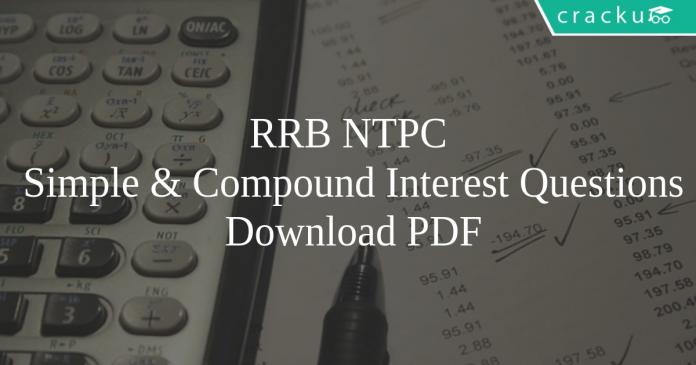RRB NTPC Simple & Compound Interest Questions PDF
Download RRB NTPC Simple & Compound Interest Questions and Answers PDF. Top 25 RRB NTPC Maths questions based on asked questions in previous exam papers very important for the Railway NTPC exam.
Download RRB NTPC Simple & Compound Interest Questions PDF
RRB NTPC Previous Papers [Download PDF]
Get 1 Year pass for just Rs. 200 – Enroll here
Question 1: Mukesh has 30000 rupees with him. He deposits this amount in two different banks. The first bank offers a simple interest of 12 % per annum and the second bank offers a compound interest of 10 % per annum. How much money (approx) should he invest in the second bank so that at the end of second year he gets same amount from both the banks?
a) 17703.67
b) 16607.14
c) 15983.25
d) 17004.33
Question 2: A bank offers a simple interest of 10 % pa. Mohit deposits 20000 rupees in the bank. He then withdraws 5000 rupees every 6 months and keeps it in his mattress. What will be the total amount with him at the end of 2 years?
a) 22500
b) 25000
c) 24000
d) 22750
Question 3: Amit invests Rs. 20,000 in two banks. He invested half of the sum in a bank that pays compound interest and half in a bank that pays simple interest. The interest rate in both the banks is 10% p.a. How much interest will he make at the end of 2 years?
a) Rs. 2,000
b) Rs. 2,100
c) Rs. 4,000
d) Rs. 4,100
Question 4: Ajay lends a sum of Rs. 1000 to Vijay at a rate of 10% p.a for a period of two years. Situation 1: Compound Interest with repayment in two equal annual installments.
Situation 2: Simple Interest with repayment after two years
In which of the two situations is total amount repaid more and by how much?
a) Amount paid in Situation 2 is more by Rs. 48
b) Amount paid in Situation 1 is more by Rs. 48
c) Amount paid in Situation 2 is more by Rs. 10
d) Amount paid in Situation 1 is more by Rs. 10
Question 5: What is the compound interest if an amount of Rs. 2500 is lent for three years at 20% p.a?
a) Rs. 1440
b) Rs. 4320
c) Rs. 1728
d) Rs. 1820
Question 6: After the demonetization announcement, Rahul went to a bank to deposit 20 notes of Rs. 500 and 30 notes of Rs. 1000. If the bank offers 12% interest compounded annually, in how many years will the amount become Rs. 50,000
a) 1 year
b) 2 years
c) 3 years
d) 4 years
Question 7: A shopkeeper bought 20 litres of kerosene type A at Rs. 30/ litres. He also bought Kerosene type B at Rs. 40/litre. He mixed both the types and sold the mixture at Rs. 45/litre and gained 20%. How much of Kerosene type B did he mix into the solution?
a) 20 litres
b) 40 litres
c) 60litres
d) 80litres
Question 8: On what sum of money will the for 3 years at 5% per annum to Rs. 630.50.
a) Rs. 1200
b) Rs. 1261
c) Rs. 4000
d) Rs. 3000
Question 9: A sum of money was invested at a certain rate for 2 years. Had it been invested at 3% higher rate of interest, it would have fetched Rs. 450 more. The sum invested was:
a) Rs. 7500
b) Rs. 600
c) Rs. 5000
d) Rs. 4500
RRB NTPC Previous Papers Download PDF
RRB JE PREVIOUS PAPERS DOWNLOAD
Question 10: Find the net profit % if the mark up % is 30% and the discount% is 10%?
a) 13%
b) 21%
c) 15%
d) 17%
Question 11: If the interest is compounded annually and the compound interest after 3 years at 10% per annum on a sum is Rs. 331, the principal is
a) Rs. 900
b) Rs. 1000
c) Rs. 1050
d) Rs. 1100
Question 12: At what rate of compound interest a sum will be $\frac{25}{16}$ times of itself in 2 years?
a) 16%
b) 18%
c) 20%
d) 25%
Question 13: The simple interest on a certain sum at the rate of 4% per annum in 4 years is Rs. 80 more than the simple interest on the same sum at 5% per annum after 3 years. The sum is
a) Rs. 7000
b) Rs. 7,500
c) Rs. 8000
d) Rs. 8,500
Question 14: A certain amount of money becomes 4 times after 12 years when kept at a certain rate of simple interest. Find the ratio of the net amount after 2 years to the initial amount if the same principal was compunded annually at the same rate of interest?
a) 1,625
b) 6,25
c) 1.25
d) 1.5625
Question 15: Find the difference between the CI and SI for the principal of Rs 10,000 for two years at the rate of 10% per annum if the principal is compounded half yearly.
a) 150
b) 155
c) 145
d) 165
18000+ Questions – Free SSC Study Material
Download General Science Notes PDF
Question 16: One-fourth of an amount was loaned at simple interest with 2% rate of interest and the remaining part was lent on simple interest at 3% rate of interest What is the average rate of interest for the whole amount ?
a) $2\frac{1}{4}\%$
b) $2\frac{3}{4}\%$
c) $1\frac{1}{4}\%$
d) $4\%$
Question 17: A certain amount which was loaned on simple interest doubled in 10 years Then the amount received is loaned on compound interest for another 2 years on the same rate What is the total rise in the amount after 12 years with the initial principal amount ?
a) 42%
b) 142%
c) 242%
d) 150%
Question 18: The simple interest at the rate of 8% on the amount Rs. 20,000 for 3 months is
a) 400
b) 600
c) 500
d) 200
Question 19: What is the interest earned in the second year on a sum of Rs 20,000, compounded annually at 10% p.a.?
a) Rs 2200
b) Rs 2000
c) Rs 2400
d) Rs 1800
Question 20: On what sum of money will the compound interest for 3 years at 5% per annum amount to Rs. 630.50 ?
a) Rs. 1200
b) Rs. 1261
c) Rs. 4000
d) Rs. 3000
Question 21: One-Sixth of an amount was given on simple interest with the rate of 3% and remaining amount was given on the simple interest rate of 5%. What will be the avg. rate of the whole amount? (Time is same for both the interests)
a) 25/6%
b) 34/5%
c) 27/7%
d) 28/6%
Question 22: A certain amount get tripled when given on a simple interest for 20 years. Then the amount received is given on compound interest for 2 years on the same rate. What will be the the total rise after 22 years with the initial principal amount?
a) 363%
b) 263%
c) 163%
d) 178%
Daily Free RRB Online Tests for RRB Exams
Question 23: What is the sum which earns Rs. 420 as compound interest in second year at the annual interest rate of 5% ?
a) Rs. 4,000
b) Rs. 42,000
c) Rs. 8,000
d) Rs. 21,000
Question 24: A person invested some money at the rate of 6% simple interest. At the end of three years, he got Rs. 900 as SI. If interest is put at the rate of compound interest annually, how much more interest would he got in three years?
a) Rs. 38.13
b) Rs. 25.33
c) Rs. 55.08
d) Rs. 35.30
e) Other than those given as options
Question 25: A person invested certain amount in Scheme A which offers 5% Simple Interest. Had he invested in Scheme B which offers 5% Compound Interest, he would have earned Rs.100 more. Find the sum.
a) Rs.1000
b) Rs.10000
c) Rs.5000
d) Rs.40000
Download Current Affairs Questions & Answers PDF
Answers & Solutions:
1) Answer (B)
Let us assume that Mukesh deposited x in second bank. So at the end of 2 years it will become 1.21x in bank 2.
Now he must have invested 30000 – x in bank 1.
The interest earned will be (30000 – x)*.12*2 = .24*30000 – .24x = 7200 – .24x
Hence, the amount will be 7200 – .24x + 30000 – x = 37200 – 1.24x
We have been given that 1.21x = 37200 – 1.24x
=> 2.24x = 37200
=> x = 16607.14
Hence, option B is the correct answer.
2) Answer (A)
For first 6 months principal will be 20000. For the next 6 months, it will be 15000. For next 6 months, it will be 10000. For last six months it will be 5000.
Thus, the interest earned by him will be
20000*10*.5/100 + 15000*10*.5/100 + 10000*10*.5/100 + 5000*10*.5/100
=> 1000 + 750 + 500 + 250 = 2500
Hence, total amount will be 22500.
3) Answer (D)
The principal in the bank with simple interest is Rs. 20,000/2 = Rs. 10,000
Interest earned = 10,000 * 2 * 10% = Rs. 2,000
The principal in the bank with compound interest is Rs. 20,000/2 = Rs. 10,000
Interest earned = $10,000 * 1.1^2$ – 10,000 = Rs. 2,100
Total interest earned = 2,000 + 2,100 = Rs. 4,100
4) Answer (A)
Situation 1:
Let the installment amount = x
Amount after 1 year = 1000 + 1000*10% = 1100
Amount for second year after repaying installment = 1100 – x
Amount to be paid after 2 years = (1100 – x) + (1100-x)*10% = 1.1(1100-x)
This should be equal to x. Hence we have
1.1(1100-x) = x => x = 576.20
Hence total amount paid = 576.20 * 2 = 1152.4
Situation 2:
Total interest = 2 * 1000*10% = Rs. 200
Hence Total amount repaid = 1200
Hence the amount paid in situation 2 is more than the amount paid in situation 1 by around Rs. 48.
5) Answer (D)
The amount to be returned at the end of three years equals $2500 \times (1+0.2)^3 = 2500 \times 1.728 = 4320$
Therefore the compound interest equals $4320 – 2500 = 1820$
6) Answer (B)
Total amount deposited = 20 * 500 + 30 * 1000 = 10,000 + 30,000 = 40,000
So, the amount after 1 year = 40,000 * 1.12 = Rs. 44,800
Amount after 2 years = 44,800 * 1.12 = Rs. 50,180
So, it takes 2 years for the amount to become Rs. 50,000
7) Answer (C)
Let x be the litres of kerosene type B bought by the shopkeeper.

1/3 = 20/X
x = 60
So the answer is option C.
8) Answer (C)
$ P (1 + .05) ^ {3}$ – P= 630.5
Solving for P, we get P = 4000
9) Answer (A)
Let $x$ be the sum of money invested at simple interest and $r$ be the rate of interest.
The interest at the end of 2 years=$P$x$t$x$r/100=2xr$ -(1)
The interest at the end of 2 years if $r$ is increased by 3%=$2x(r+3)$ -(2)
Given (2)-(1)=450
=>$6x=450$
∴$x= 7500$
10) Answer (D)
Let the CP = 100
Mark Up = 30%
MP = 130
Disount = 10%
SP = 90% of 130 = 117
Gain% = (117-100)/100 = 0.17 = 17%
11) Answer (B)
$ P \times (1 + \frac{10}{100}) ^{3} $= P + 331
1.331P = P + 331
So, P = 1000
12) Answer (D)
P * $ (1 + \frac{r}{100})^{2} = P * \frac{25}{16} $
Implies $ (1 + \frac{r}{100})^{2} = \frac{25}{16} $
$ 1 + \frac{r}{100}= \frac{5}{4} $
r = 25%
13) Answer (C)
Let the principal be P
SI = P xT x R/100
difference = P x 4 x 4 /100 – P x 5 x 3/100
= 16P/100 – 15P/100 = 80
P = 8000 Rs.
14) Answer (D)
Since the money becomes 4 times
3x = x*r*12/100
r = 25% p.a.
Net amount after 2 years = x$(1+r/100)^2$
Net amount after 2 years/x =$1.25^2$ = 1.5625
15) Answer (B)
$SI =\frac{P*R*T}{100}$
$SI =\frac{10000*10*2}{100}$
SI = Rs 2000
Amount after 2 years = P$(1+\frac{R}{100n})^{nt}$
n = 12/6 (Since the interest is compounded semi annually) = 2
Amount after 2 years = 10000$(1+\frac{10}{100*2})^{2*2}$ = 12155.0625
CI = 12155.625 – 10000 = Rs 2155.625
CI-SI = Rs(2155.0625-2000) = Rs 155.0625
16) Answer (B)
Let the amount be 100 Rs.
One fourth of it is at 2 % pa
So, 25 x 2 x 1 /100 = .5
The rest is on 3% pa interest.
So, 75 x 3 x 1 /100 = 2.25
So total interest = 2.75
Interest rate = ?
Interest rate = i x 100/ pt
= 2.75 x100/100 = 2.75%
17) Answer (B)
The amount doubled in 10 years. So, the interest = principle.
So, rt/100 = 1
r = 10% pa
Now compound interest = ?
2P $(1 + .1) ^ {2}$ = 2P x 1.21 = 2.42P
Total rise is P to 2.42P = rise of 142%
18) Answer (A)
S.I=P x r x t/100 , t in years
=(20,000 x 8 x 3)/( 100 x 12)=400
19) Answer (A)
Interest earned in the first year = 20000 * 1 * 10/100 = Rs 2000
Principal for the second year = Rs 20,000 + Rs 2,000 = Rs 22,000
So, interest for the second year = 22000 * 1 * 10/100 = Rs 2200
20) Answer (C)
$ P (1 + .05) ^ {3}$ – P= 630.5
Solving for P, we get P = 4000
21) Answer (D)
Let’s say amount is x and rate is r% for t time
So Total simple interest will be = \frac{xrt}{100} = \frac{3xt}{600} + \frac{25xt}{600}
Hence, r = $\frac{28}{6} \% $
22) Answer (B)
Let’s say initial amount = x
after simple interest = 3x
Simple interest = 2x = x*($\frac{r}{100}$)*(20)
So r = 10%
Now after giving the amount on compound interest, amount will be = $3x(1+10\%)^{2} = 3.63x$
Increment from the initial principal amount = 2.63x i.e 263%
23) Answer (C)
x * 1.05 * 1.05 – x * 1.05 = 420
implies x = 8000 Rs.
24) Answer (C)
S.I=900=6/100 x 3 x P
=>P=5000
C.I amount=A=P(1 + r/100)$^{t}$=5000(1 + .06)${3}$
=5955.08
=>C.I=955.08
∴ the person would get Rs 55.08 additionally.
25) Answer (B)
Let the principal be Rs.10000
Simple Interest at 5% SI for 2 years = $\dfrac{10000\times5\times2}{100} = Rs.1000
Amount for 1 year at 5% CI = 105% of Rs.10000 = Rs.10500
Amount for 2 years at 5% CI = 105% of Rs.10500 = Rs.11025
Total Compound Interest = Rs.11025 – Rs.10000 = Rs.1025
Difference between SI and CI = Rs.1025 – Rs.1000 = Rs.25
Given that the difference = Rs.100
Rs.25 → Rs.100
Rs.10000 → ?
= $\dfrac{10000\times100}{25} = Rs.40000$
Hence, Principal = Rs.40000
DOWNLOAD APP FOR RRB FREE MOCKS
We hope this Simple & Compound Interest questions for RRB NTPC Exam will be highly useful for your preparation.





